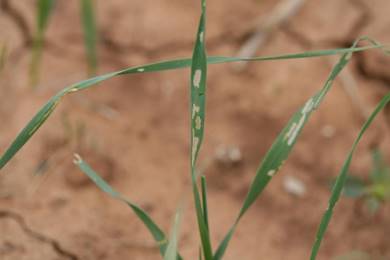Paul Beck, Oklahoma State University Extension Beef Nutrition Specialist
In my weekly trips to western Oklahoma, I have noticed that areas have received enough rainfall to start planting wheat. Several fields look to have been planted early and have very nice stands, while planting in areas with good moisture is progressing rapidly. It appears that some of our focus has shifted away from maximum grain production to earlier planting to enhance wheat forage production due to our poor range conditions and short hay crop.
Fall armyworms are a big concern because we have at least 6 weeks before our first killing frost. This is time to allow for at least two generations of moth flights for laying eggs. Fall armyworms affect sorghum and corn, so they can act as bridge crops for armyworms that can affect our early planted fall wheat fields, there may be multiple generations of armyworm larva. Early planted wheat grows slowly due to the warmer temperatures and armyworm larva can keep up with the wheat growth causing major damage.
Armyworm moths can lay 1,000 eggs, which can hatch in 3 to 10 days. The caterpillars molt 6 times over 21 to 28 days increasing in size with each molt, or ‘instar’ stage. Mature fall armyworms are green to brown and are 1.5 inches long with an inverted Y on their head.
It is important to scout fields and detect armyworm larva at early stages or ‘instars’. Early instars are more susceptible to insecticide products and they do not cause as much damage. Armyworms are very hard to see until they reach instar 4 or 5, but they consume 94% of their lifetime forage intake during their last 5 to 6 days during instars 5 and 6. Mature larva are voracious feeders and can consume a field in just a few days. Smaller larva do not eat through the leaf but consume the green tissue in a leaf, leaving a clear membrane that looks like a window pane.

Scout at least 5 to 10 locations in the interior of each field. Treatment should occur when there are 2 to 4 caterpillars in a linear foot of a row with feeding damage present.
For detailed treatment guidelines consult OSU Factsheet CR7193 Management of Insect Pests in Rangeland and Pasture | Oklahoma State University (okstate.edu) and CR7194 Management of Insect and Mite Pests in Small Grains | Oklahoma State University (okstate.edu)
Dr. Tom Royer discussed Winter Wheat Management for Fall & Winter Pests on Rancher’s Thursday Lunchtime Series from November 2020. https://www.youtube.com/watch?v=PbmiTsGSdh0
